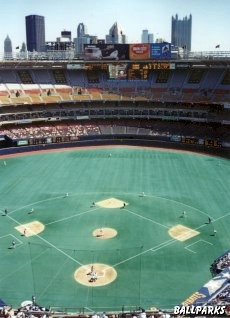Stadium Pittsburgh, Pennsylvania Tenants: Pittsburgh Pirates (NL); Pittsburgh Steelers (NFL) Architect: Deeter Ritchy Sipple, Michael Baker, Jr. and Osborn Engineering Pittsburgh Pirates tickets:
Location: 600 Stadium Circle. Left field (E), Interstate 279 Fort Duquesne Bridge approach ramp; third base (N), Reedsdale Street; first base (W), Allegheny Avenue, Ohio River, and the original point where the Monongahela River joins the Allegheny River to form the Ohio River; right field (S), North Shore Avenue, Roberto Clemente Memorial Park, Allegheny River; Stadium Circle encircles the park. Dimensions: Foul lines: 340 (1970), 335 ft. (1975); power alleys: 385 ft. (1970), 375 ft. (1975); center field: 410 ft. (1970), 400 ft. (1975); backstop: 60 ft., foul territory: large. Fences: 10 ft. (wood).
Three Rivers Stadium's name referred to where it sat, where the Allegheny and Monongahela Rivers join to form the Ohio River. It sat almost precisely on the site of Exposition Park, which housed the Pirates for 19 years from 1891-1909. It also sat on a Delaware Indian burial ground, and the location was the site of many battles fought by General George Washington over possession of nearby Fort Duquesne. Pirates management tried to preserve a piece of the club’s past by moving the 18-foot, 1,800-pound statue of Hall of Fame shortstop Honus Wagner, which had stood behind the left-field wall at Forbes Field, into Three Rivers Stadium. A section of the wall where Bill Mazeroski hit his famous home run that ended the 1960 World Series with a Pirates victory over the Yankees sat in the Allegheny Club, a dining and viewing area in the stadium. The process of building the stadium actually began in 1948, when the first proposal was made to replace Forbes Field, then the Pirates' home. The old ballpark was quickly falling into disrepair, and its 35,000-seat capacity was inadequate. A site on the north side of the city was chosen in 1958, but a series of political squabbles and labor disputes delayed the project for a decade. Finally, on April 25, 1968, construction began. The stadium was scheduled to open for the start of the 1970 season, but unlike Forbes, which had been built in four months, construction at the new site dragged on. The stadium wasn’t ready on Opening Day, nor was it ready for its revised target date of May 29, because the lights had yet to be put in place. Finally, on July 16, the new stadium was ready. It had cost $40 million.
Trivia:
More on Three Rivers Stadium: Recommended Reading (bibliography):
Help us provide a better web site by completing our feedback form Three Rivers Stadium with downtown Pittsburgh © 1999 by Paul Munsey. Updated April 2005 Tickets to MLB All Star game, NCAA Basketball Tournament, College Football Bowl, NCAA Football, Paul McCartney and Pittsburgh Pirates provided by Ticket Triangle. BALLPARKS © 1996-2014 by Munsey & Suppes.
|







